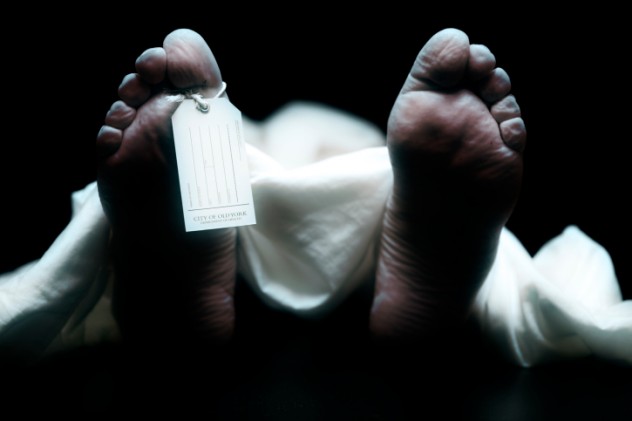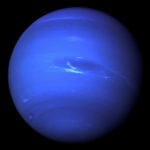 Weird Stuff
Weird Stuff  Weird Stuff
Weird Stuff  Our World
Our World 10 Ways Your Christmas Tree Is More Lit Than You Think
 Movies and TV
Movies and TV The 10 Coolest Stars to Set Sail on The Love Boat
 History
History 10 Things You Didn’t Know About the American National Anthem
 Technology
Technology Top 10 Everyday Tech Buzzwords That Hide a Darker Past
 Humans
Humans 10 Everyday Human Behaviors That Are Actually Survival Instincts
 Animals
Animals 10 Animals That Humiliated and Harmed Historical Leaders
 History
History 10 Most Influential Protests in Modern History
 Creepy
Creepy 10 More Representations of Death from Myth, Legend, and Folktale
 Technology
Technology 10 Scientific Breakthroughs of 2025 That’ll Change Everything
 Weird Stuff
Weird Stuff Ten Bizarre Facts About The Doge Meme
 Our World
Our World 10 Ways Your Christmas Tree Is More Lit Than You Think
 Movies and TV
Movies and TV The 10 Coolest Stars to Set Sail on The Love Boat
Who's Behind Listverse?

Jamie Frater
Head Editor
Jamie founded Listverse due to an insatiable desire to share fascinating, obscure, and bizarre facts. He has been a guest speaker on numerous national radio and television stations and is a five time published author.
More About Us History
History 10 Things You Didn’t Know About the American National Anthem
 Technology
Technology Top 10 Everyday Tech Buzzwords That Hide a Darker Past
 Humans
Humans 10 Everyday Human Behaviors That Are Actually Survival Instincts
 Animals
Animals 10 Animals That Humiliated and Harmed Historical Leaders
 History
History 10 Most Influential Protests in Modern History
 Creepy
Creepy 10 More Representations of Death from Myth, Legend, and Folktale
 Technology
Technology 10 Scientific Breakthroughs of 2025 That’ll Change Everything
10 Unexplained Mysteries From Arkansas
Don’t let the serenity of the Arkansas landscape fool you. The Natural State has more than enough of its dark secrets and skeletons in the closet to ruin the serenity. Read on to find out the 10 creepiest.
10 Old Mike

In the early 1900s, down in Nevada County, the man who would come to be known as “Old Mike” was a familiar face in and around the city of Prescott. A traveling salesman, he would swing by each month to sell stationery to homes and local businesses. He occasionally stayed overnight, but he always left the following day on the afternoon train.
One day, residents found Mike lying motionless under a tree. He had apparently passed away the night before. Knowing him only by his first name—and after a postmortem search failed to turn up any identification—the townspeople did the only sensible thing they could think of. They embalmed him and put his corpse on display outside of the local funeral home.
That’s where Mike sat for the next six decades. He was originally placed there in hopes that someone would identify him or claim the body, but no one ever came forward. Eventually, in 1975, the state attorney general’s office requested that he be buried, and Mike was finally laid to rest later that May. His true identity will likely forever remain a mystery.
9 Ghost Lights
Ghost lights—or “will-o’-the-wisps,” as they’re known in Europe—are staples of paranormal folklore. Like a handful of other states in the South, Arkansas has two ghostly orbs of its own, one in Gurdon and another in Crossett. Both are similar in appearance, with witnesses describing them as glowing white lights that occasionally move throughout the woods. What’s more, both lights share equally murky origins.
The Gurdon Light was first spotted in the early 1930s, following the murder of a railroad foreman. Local researchers point to the gruesome slaying of William McClain for the legend’s authenticity. Meanwhile, the Crossett Light also originated from a fatal railroad incident, this time with the unlucky worker being beheaded by the train. The legend’s telling varies, though, with one version claiming that the light is the ghost of the decapitated rail worker looking for his head. Another attributes the light to his wife’s lantern, as she eternally searches for her husband’s body.
8 The Fouke Monster

When traveling through southwest Arkansas, we advise sticking to the main roads. Those brave enough to wander into the woods risk running into the nefarious Fouke Monster. Also called “the Southern Sasquatch,” sightings of the Fouke Monster date back to the 1940s, but arguably the most famous accounts occurred in the early ’70s.
In 1971, Bobby Ford told police that he was attacked by a man-like creature standing over 2 meters (7 ft) tall with red eyes. Ford claimed that he’d spotted the beast only days before on a hunting trip, and decided to shoot at it with his buddies. It was on his porch and presumably seeking revenge.
Before being treated at the hospital for minor injuries, Ford explained to the officers that he routinely spotted the monster on his property terrorizing his livestock, so they decided to investigate. The police failed to find any blood from a supposed wound inflicted by Ford, but they did find a strange set of tracks out in the woods, as well as scratches on Ford’s door. A reporter from the local paper thought enough of the incident to file a story, earning the attention of low-budget filmmakers, who turned the encounter into a clumsy horror movie that propelled the creature to national stardom. The movie spawned four sequels. The History Channel even got in on the action, sending its MonsterQuest team to investigate in 2009.
In recent years, sightings have been sporadic. While the ’70s saw interest in the Fouke Monster peak—a local radio station even put out a bounty for its capture—the late ’90s was the last time the mysterious beast ever saw a resurgence in popularity. To further muddy the legend, independent researchers have argued that the tracks found by Ford and others were forgeries. Dr. Frank Schambagh, a professor at Southern Arkansas University, said that the tracks were man-made and that the anatomy of the Fouke Monster didn’t fit with the known species of primates. Either way, we’ll take our chances with the well-lit, paved areas of Fouke when passing through.
7 Crop Circles

Crop circles first popped up in Arkansas in summer 2003. They appeared as a series of 10 circles as large as 9 meters (30 ft) in diameter. Two more appeared in the following years—one in 2004 in Peach Orchard and another in Delaplaine three years later, two towns less than five miles apart. In recent years, more designs have been popping up in southern areas of the state as well.
There’s not much evidence to support ET being behind the crop circles, and farmers are similarly skeptical that it’s the work of pranksters. As of this writing, though, no one has come forward claiming responsibility.
6 The Crawford Disappearance

Arkansas was a hotbed for mob activity in the first half of the 20th century. Al Capone was a frequent visitor to the state in the 1920s, spending ample time in Hot Springs to bet on horse races at Oaklawn and relax in some of the many bathhouses that lined Central Avenue. Naturally, a state this friendly to mobsters was bound to have a fair amount of shady business deals. That’s where Maud Crawford came in.
A well-known public figure in Camden and a pioneer for women in Arkansas, Crawford worked as a court stenographer before she decided to take the bar exam. Having had no formal legal classes, she aced the exam and eventually became an expert in abstract and title law. At the time of her disappearance, she was even assisting Sen. John McClellan with a congressional investigation into supposed mob ties with organized labor. Crawford’s last known whereabouts place her at home.
Her husband, Clyde, returned to their house to find her car still in the driveway, the TV on, and money in her purse. Their supposed guard dog wasn’t even fazed. The police began searching for her the next morning, but found few clues as to what could have caused her disappearance. Her body was never recovered.
In the mid-1980s, a series of articles in The Arkansas Gazette alleged that her disappearance involved Arkansas State Police Commissioner Mike Berg. Crawford was looking into a potentially illegal transfer of assets between Berg and some of his family members. Only days before disappearing, she had confronted him face-to-face about the issue. According to the articles, Odis A. Henley, the officer originally assigned to the case, reported to his superiors that all the evidence he uncovered implicated Berg as her killer. This contradicted official statements from the Ouachita Sheriff’s department that they had yet to turn up any clues in her disappearance.
His findings did little to sway the rest of the force, Henry recounted, and he was reportedly told by his superiors that “there’s too much money involved” before being reassigned. Adding to the intrigue, all of his files on Crawford disappeared after a short trip away from the office. Legally declared dead by Ouachita County in 1969, Crawford’s death was found to be the result of “foul play perpetrated by person or persons unknown.”
5 The Guy Earthquake Swarms

A small community just north of Little Rock, Guy wasn’t accustomed to drawing national attention. That all changed in 2010, when a series of relatively minor earthquakes shook the town. The first swarm struck in fall 2010, with most quakes registering under 2.0 on the Richter scale, meaning not everyone in town may have felt or even noticed the shaking. However, the swarms continued over the next two years and increased in magnitude, with one reaching as high as 4.7 in February 2011.
With the trembling becoming more noticeable, residents began to wonder if the quakes were a result of hydraulic fracturing techniques being used to drill for oil and gas in the area. The Arkansas Geological Survey was called out to investigate, and while the group noted that there is some evidence that fracking can cause minor earthquakes, they found no link between the drilling and these particular swarms.
Earthquake swarms aren’t entirely unusual in Arkansas. The state’s had a handful of them before, but none have reached the magnitude of those in Guy. Through 2013, over 500 quakes have rocked the town. As northeast corner of Arkansas was home to one of the country’s most violent swarms—the 1811-12 New Madrid earthquakes—the seemingly endless quakes have left some residents particularly on edge.
4 The Moonlight Murders

The sleepy town of Texarkana was shaken by a series of vicious slayings in the spring of 1946. The white-hooded “Phantom Killer” preyed on young couples who escaped to secluded areas late at night. He was only active for a three-week period between April and May, but in that span, he attacked eight people, killing five. In an effort to halt the violence and capture the suspect, police put the city under lockdown each day at dusk, patrolling the streets in heavily armed patrols.
Just as mysteriously as the killings started, however, they subsided. Police quickly orchestrated an intense investigation. Key witnesses were examined, leads were hunted down, evidence was poured over—but nothing concrete ever came from it. All investigators could confirm was that the killer was a man who wore a white hood, preferred to attack young people late at night in isolated areas, and often used a gun to kill his victims.
Relatively little new information ever surfaced in subsequent years. Adding to the creepiness of the case, some self-proclaimed web-sleuths have tenuously linked the Phantom with San Francisco’s notorious Zodiac Killer. They cite both killers’ specific victims, method of operation, preferred murder weapon, and the similar—albeit stretched—time period as evidence of a connection.
Nearly three decades after the investigation hit a dead end, Texarkana’s Charles B. Pierce made a movie loosely based off of the events, titled The Town That Dreaded Sundown. A remake is tentatively scheduled to start production later this year.
3 The Edwards Murder

In the 1970s, Arkansas wasn’t the most hospitable place for an unwed mother of three. When Linda Edwards got a job as dispatcher for the Garland County Sheriff’s Office, she considered it a godsend—but just six months after joining the force, she vanished. Rumors began to circulate that the man she had been having an affair with, Sgt. Thurman Abernathy, had gotten her pregnant. She wanted to keep the baby, he didn’t. When a fight broke out between the two, he allegedly killed her. Along with their stormy relationship, further implicating Abernathy in her murder was testimony from Edwards’ friend, Mary Patterson, who told police that Edwards was going to meet Abernathy the night she disappeared.
While the missing person’s case dragged on for close to a year, things took a frightening turn when a hunter stumbled upon Edwards’ partially buried remains in the woods. Medical examiners reported that she died from blunt-force trauma to her skull. A few months later, Abernathy was formally charged with her murder.
Knowing that most of the evidence against him was hearsay, Abernathy decided to appeal his case. While the appeal wound its way through the courts, the case was passed along to newly appointed prosecutor Dan Harmon. Harmon dropped all charges against Abernathy, who had recently been promoted to lieutenant. A grand jury agreed with him, citing insufficient evidence. Despite an intense statewide investigation, no tangible evidence has ever surfaced linking Abernathy to Edwards’ murder, and the case remains unsolved.
2 John Glasgow Vanishes

The idea that someone could complete disappear in the digital age seems rather implausible, but that’s exactly what John Glasgow did in 2008. Whether it was by choice, though, we’ll never know. A prominent figure in the Little Rock construction industry, Glasgow was raking in a seven-figure salary as CEO of CDI Contractors when he—allegedly—backed out of his driveway at 5:15 a.m. on January 28 to leave for work. That’s the last time anyone ever saw him.
It’s never been confirmed that the person reversing his black SUV was him, but when his office called his wife later that day asking where he was, she knew something was terribly wrong. It was unusual for husband not to keep in touch. Within hours, she had organized a search party. They traveled to Petit Jean Mountain, the location of his last cell phone signal, and found his SUV parked outside the Mather Lodge. Inside the vehicle they recovered his phone, two credit cards, and his laptop. The only items missing were his keys and wallet. The trail went cold from there.
In the days following his disappearance, rumors started circulating. Some said that it was a result of his “strained” relationship with Dillard’s, the parent company of CDI, as he was being audited at the time. Friends said he was anxious over it. Others countered that he was in “good spirits” before he vanished. Eventually, Glasgow and his company were cleared of anything illegal by the audit. However, investigators noted that Glasgow received a hefty bonus before he vanished. They thought maybe that was evidence of a possible ransom or extortion, but the money in his bank accounts hasn’t been touched.
The case took a strange turn in 2012, when Jonathan Brawner, a convicted felon and prison barber at the Faulkner County jail, made local headlines after claiming that he and a few accomplices had buried Glasgow four years prior. An exhaustive search of the area returned no corroborating evidence, however, and new evidence of his whereabouts has yet to surface.
1 The Train Deaths

Arguably the state’s most notorious cold case, the mysterious deaths of Don Henry and Kevin Ives still haunt Central Arkansas. In the early morning hours of August 23, 1987, the mangled bodies of Henry and Ives were discovered on a set of railroad tracks in Bryant, a suburb just south of Little Rock. The train’s engineer didn’t see the boys in time to stop. He told police that they were laying motionless on the tracks, parallel to one another with their arms straight down at their sides, their bodies partially covered by a green tarp.
The initial investigation was swift. Police ruled their deaths accidental, with the state medical examiner declaring that they were under the influence of marijuana and had passed out on the tracks. However, the boys’ parents didn’t agree with that conclusion—they were certain their sons died of foul play. After fighting to get the case reopened, they finally succeed in early 1988 when a new prosecutor was assigned to the case. One of Richard Garrett’s first directives was to have the bodies exhumed for further examination.
His findings where chilling, to say the least. Medical examiners reported that both boys had suffered injuries prior to the train accident. Henry’s shirt was in tatters, with lacerations all over his body indicative of stabbing. Ives, meanwhile, had blunt force trauma to his skull. Examiners concluded that both were dead before being run over by the train. The reported green tarp was never seen again.
Then things got weirder. Witnesses came forward with testimony that they’d seen police officers beating the boys “senseless” before tossing them in the back of a truck and speeding off. Others reported seeing a man in military fatigues loitering near the section of tracks where the boys’ bodies were discovered. Speculation began to rise, with many residents wondering if the boys had simply been in the wrong place at the wrong time. Maybe they had seen a “drug drop” that was connected to alleged cocaine smuggling via the Mena Airport. Others insisted that they saw a Bryant official—that Dan Harmon fellow we mentioned earlier, to be exact—partaking in a drug deal, and the boys were simply victims of being potential witnesses that could jeopardize a political career. Harmon was later arrested on charges for running a drug ring, selling primarily cocaine, from his office.
The parents did see some justice from all these developments. A grand jury reversed its original verdict of “probable homicide” to “definite homicide” and Arkansans haven’t forgotten the boys on the tracks. Residents honored their memory with a memorial last spring. After 25 years, though, it appears as if the case will forever remain unsolved.
Sports reporter by day, internet sleuth at night, keep up with Brandon at On Campus Sports, Highlands Today, or on Twitter.








